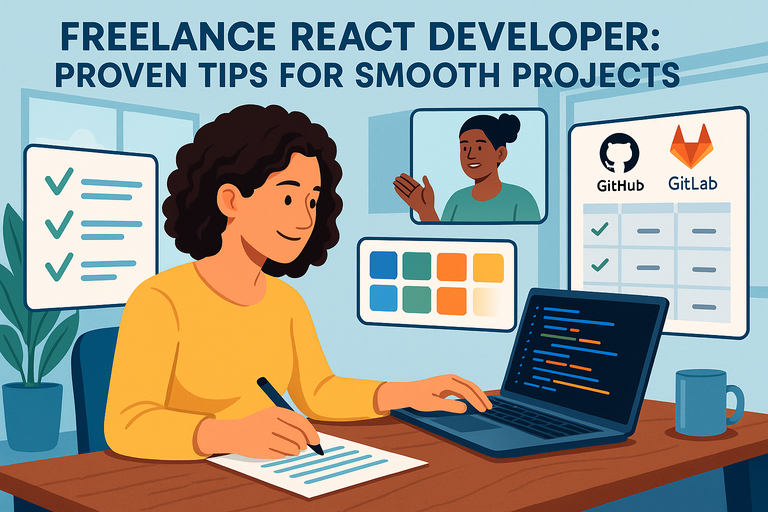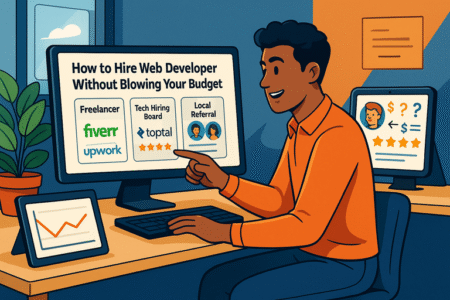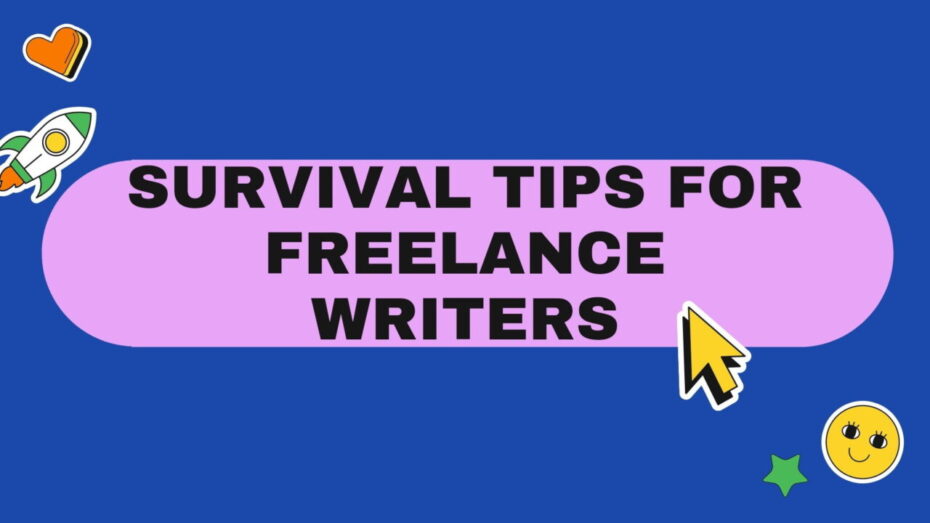Table of Contents
Hiring a freelance React developer can feel both exciting and overwhelming. The flexibility of working with a freelancer is great, but how do you make sure your project actually runs smoothly from start to finish? Many teams get stuck on communication issues, vague timelines, or missed expectations.
This guide unpacks proven tips that will help you avoid those pitfalls and answer the big question: How do you get the best results when working with a freelance React developer?
Define Clear Project Goals Before Hiring
If you’re about to bring on a freelance React developer, the very first thing you need is clarity. Without well-defined goals, even the most talented developer can end up building something that misses the mark.
This step is about removing guesswork so both you and your freelancer are aligned on exactly what success looks like.
Write A Detailed Project Scope That Eliminates Guesswork
Think of a project scope like the GPS for your app. Without it, you’re just driving aimlessly and hoping you end up at the right destination. A strong scope doesn’t just say “build a dashboard”; it explains what the dashboard should do, who will use it, and how it should function.
Here’s what I suggest including in your scope:
- Core Features: List the must-haves (e.g., user authentication, API integration, form validations).
- Tech Stack Requirements: Specify if you want Redux for state management, Tailwind for styling, or TypeScript for stricter type safety.
- Design References: Screenshots, Figma files, or even links to apps you admire help paint a clear picture.
- Constraints: Anything off-limits? Mention it upfront (e.g., no external UI libraries, specific API limits).
I once worked with a client who simply said, “Build a product page.” No details, no specs. A week later, we had three completely different versions of a product page floating around.
The problem wasn’t skill—it was lack of clarity. A scope document would have prevented wasted time and frustration.
Set Specific Deliverables And Measurable Outcomes
General goals like “make it user-friendly” sound nice, but they don’t give your developer anything concrete to work with. Instead, translate those into measurable outcomes.
For example:
- “The page must load in under 2 seconds on 4G.”
- “The login form must validate emails and passwords in real time.”
- “The product search should display results in less than 300ms.”
Deliverables should also be broken into tangible outputs:
- A working React component library.
- An integrated payment checkout flow.
- A deployment-ready staging environment.
From what I’ve seen, when goals are quantifiable, it’s easier to track progress and avoid awkward conversations later about whether the project is “done.”
Break Down Features Into Prioritized Milestones
Not every feature needs to be built right away. In fact, trying to deliver everything at once usually slows you down. This is where milestones save the day.
Here’s how I like to structure them:
- Milestone 1: Core authentication and routing setup.
- Milestone 2: User dashboard with primary functionality.
- Milestone 3: Integrations like payment, email, or third-party APIs.
- Milestone 4: UI polish, accessibility testing, and performance tuning.
When milestones are prioritized, you can launch earlier with a working product and add polish later. It also keeps motivation high—there’s something energizing about seeing small wins stack up quickly.
Choose The Right Freelance React Developer For Your Needs
Even with perfect goals, the wrong developer can still derail your project. Choosing the right freelance React developer is part skill evaluation, part personality fit, and part good detective work. This isn’t just about finding “a React dev”—it’s about finding your React dev.
Review Technical Skills Beyond Just React Knowledge
React is the centerpiece, sure, but modern applications are rarely React-only. I recommend looking for developers who have:
- State Management Experience: Redux, Zustand, or Context API.
- API Integration Skills: REST and GraphQL knowledge is essential for real-world apps.
- Build Tools Familiarity: Webpack, Vite, or Next.js.
- Testing Knowledge: Jest, React Testing Library, or Cypress.
A developer who only knows React is like a chef who only knows how to boil pasta. Yes, they can cook, but can they serve a whole meal? You want someone who can handle the supporting technologies that make a React app production-ready.
One quick test I’ve used: Ask how they’d structure a reusable modal component. If they can talk through accessibility (ARIA roles, focus traps) and performance (lazy-loading where possible), you know they’re not just winging it.
Assess Communication And Collaboration Style Early On
Technical chops are half the battle. The other half is whether you can actually work together. Communication style makes or breaks freelance projects.
- Do they ask clarifying questions, or do they just nod and disappear?
- How fast do they respond to emails or Slack messages?
- Can they explain technical decisions in plain language?
I believe a great freelance React developer should act almost like a teammate, not just a contractor. Someone who challenges your assumptions respectfully and keeps you updated without you chasing them down. If during the trial phase they’re hard to reach, it won’t magically improve later.
Check Portfolios For Relevant Industry Experience
A beautiful portfolio doesn’t always mean relevant experience. For example, if you’re building an eCommerce site, a portfolio filled with personal blogs won’t tell you much. Look for work samples that show alignment with your industry or project type.
Things to watch for in a portfolio:
- Complex Components: Have they built dashboards, charts, or multi-step forms?
- Mobile Responsiveness: Do their projects look good on smaller screens?
- Performance Awareness: Can you click around their live demos without lag?
I once hired a freelancer who had only done landing pages but claimed they could handle a large SaaS dashboard. Spoiler: it didn’t go well. Matching their past work to your actual needs avoids surprises.
Use Effective Communication Tools To Stay On Track
Working with a freelance React developer is a lot smoother when everyone’s on the same page. The right tools and rhythms can prevent misunderstandings and keep your project moving forward without endless back-and-forth emails.
Keep Updates Consistent With Agile Stand-Ups
One of the biggest mistakes I see is waiting until the end of a milestone to ask, “How’s it going?” By that time, it may be too late to course-correct. That’s why I suggest quick check-ins, modeled after Agile stand-ups.
These don’t need to be fancy or time-consuming. A simple daily or biweekly message covering three points works wonders:
- What was done since the last check-in.
- What’s being worked on next.
- Any blockers stopping progress.
For example, I once had a freelance React developer drop a one-line update in Slack: “Finished login form validation, now integrating with Firebase, need API keys for deployment.”
That tiny message prevented two days of delay because I immediately supplied the keys. Regular updates catch issues early and build trust fast.
Leverage Collaboration Platforms Like Slack Or Trello
Email chains are where projects go to die. Instead, centralize everything. Slack (or Discord, if that’s your vibe) is excellent for real-time conversations, while Trello, Jira, or Asana keep tasks visible to everyone.
Here’s how I recommend setting it up:
- Slack: Create a dedicated channel like #react-app-project where all project discussions live.
- Trello/Jira: Use boards with clear columns such as “To Do,” “In Progress,” and “Done.” Assign each card to the developer, with deadlines visible.
- Figma Links/Docs: Pin them to the channel so nobody has to dig through old chats.
This setup reduces “Did you get my message?” moments and helps you see progress at a glance. You’ll never have to wonder what’s happening—it’s right in front of you.
Document Every Decision To Prevent Misunderstandings
It’s easy to say, “Let’s just tweak this button later,” but unless that decision is documented, it gets forgotten—or worse, remembered differently by each person.
A simple shared Google Doc or Notion workspace can act as your “source of truth.” Every decision, big or small, gets recorded:
- Date of the decision.
- What was agreed on.
- Why it was chosen.
For example, if you decided to use React Query instead of Redux for state management, write it down. Three months later, when someone asks, “Why did we skip Redux?” you won’t be scratching your head.
I’ve seen projects balloon in cost because undocumented choices had to be re-discussed and re-implemented. A little discipline with documentation saves hours later.
Agree On A Realistic Timeline And Budget
Even with great communication, a project can collapse if expectations about time and money are off.
Setting a realistic timeline and budget with your freelance React developer isn’t just about project management—it’s about building mutual trust.
Break Timelines Into Manageable Weekly Or Biweekly Sprints
Instead of saying, “We’ll finish in three months,” break the project into smaller sprints. Weekly or biweekly sprints allow you to review progress, adjust priorities, and make sure things aren’t drifting off track.
Here’s a simple sprint setup I recommend:
- Week 1–2: Authentication system + routing.
- Week 3–4: Core dashboard components.
- Week 5–6: API integrations.
- Week 7–8: Testing + UI polish.
At the end of each sprint, review the deliverables together. This approach creates mini-deadlines, which keep momentum steady and reduce the risk of a big surprise at the end.
I once managed a React project where we skipped sprints. We aimed for a 6-week finish, but at week 5, half the work wasn’t done. Breaking it down would have exposed that risk much earlier.
Discuss Buffer Time For Unexpected Delays
Delays happen—whether it’s a last-minute design change, an API outage, or the developer catching the flu. I suggest adding a buffer of about 20% to your timeline.
So, if you think the project will take 10 weeks, plan for 12. That way, if something goes wrong, you’re not instantly off schedule. And if things stay on track? You’ll look like a hero for finishing early.
I’ve found that freelancers appreciate this honesty too. It shows you understand their work isn’t magic and that you’re willing to plan realistically.
Set Payment Milestones That Match Progress
Money can be a tricky subject, but clear agreements upfront make everything smoother. Instead of paying everything at the end, tie payments to progress milestones.
A typical structure might look like this:
- 20% upfront: Locks in the developer’s time.
- 30% at Milestone 1: Core setup completed.
- 30% at Milestone 2: Key features delivered.
- 20% on final delivery: App fully tested and deployed.
This system protects both sides: you’re only paying for work completed, and the freelancer knows they’ll get paid steadily as they deliver.
I once worked with a client who wanted to pay “when it’s all done.” Unsurprisingly, the developer ghosted halfway. With milestone payments, both sides stay committed throughout the project.
Establish A Strong Version Control And Workflow Process
When you’re working with a freelance React developer, version control isn’t optional—it’s the safety net that keeps your project stable. Without a clear workflow, you risk messy code merges, lost changes, or worse, a broken app with no way to trace what happened.
Use GitHub Or GitLab For Code Transparency
I always recommend asking your freelancer to work within a shared GitHub repository from day one. Why? Because you want transparency. You should be able to see:
- Every commit they make.
- Which branch they’re working on.
- The progress in real time.
It also gives you control. For example, if the freelance React developer suddenly becomes unavailable, another developer can jump in and pick up right where they left off. With everything tracked in Git, you’re not left stranded with a pile of zipped files.
A practical setup could be:
- Main branch: Only production-ready code lives here.
- Develop branch: Active development happens here.
- Feature branches: Each new feature gets its own branch.
That way, nothing sneaks into production without being tested first.
Define Branching And Merging Rules Clearly
Branch chaos is real. Without rules, you’ll end up with developers pushing half-baked code directly to main, breaking things for everyone. I suggest defining rules upfront:
- No one pushes directly to main.
- Every feature branch must be reviewed before merging.
- Conflicts must be resolved locally before a pull request.
For example, let’s say your developer is building a payment integration. They should create a feature/payment-gateway branch, complete the work there, and only merge it back after review. This prevents unfinished features from polluting your live environment.
Think of it like lanes on a highway. Branching rules keep traffic flowing smoothly instead of everyone swerving into each other.
Ensure Regular Code Reviews To Maintain Quality
Code reviews aren’t about nitpicking—they’re about catching issues early and maintaining standards. Even if you’re not a React expert, you can still enforce code reviews by:
- Having another developer (or tech lead) approve pull requests.
- Using GitHub Actions to automatically lint and test code before merging.
- Asking your freelancer to explain tricky pieces of logic in their commits.
In my experience, even a 10-minute review can prevent hours of debugging later. I once skipped reviews on a small project, only to find that the freelancer hard-coded API keys into the repo. If I had caught it early, I would have saved myself from a major security headache.
Prioritize Testing And Quality Assurance From Day One
Skipping testing is like skipping brakes on a car—it may save time upfront, but you’ll regret it when things crash. A freelance React developer should be comfortable with testing practices, and you should insist on it early.
Set Up Automated Testing To Catch Bugs Early
Automated tests are your safety net. They run in the background and make sure new code doesn’t break old code. I recommend at least three layers:
- Unit tests: Check small pieces like functions and components.
- Integration tests: Verify that modules work together correctly.
- End-to-end tests: Simulate real user flows (e.g., signing up, checking out).
Tools like Jest and React Testing Library make unit testing straightforward. For end-to-end, Cypress is my go-to. Imagine pushing a new login feature—automated tests can instantly check if the signup, login, and logout flows still work. No surprises after deployment.
Involve QA Review At Every Milestone
Don’t wait until the very end to test. Quality assurance should be baked into each milestone. After finishing Milestone 1 (say, authentication), test it thoroughly before moving on.
A QA checklist for something as simple as a login page might include:
- Valid credentials log you in correctly.
- Invalid credentials trigger error messages.
- The “forgot password” flow works on desktop and mobile.
I once saw a team delay QA until final delivery. The result? Fixing a dozen bugs spread across five features at once, instead of catching them earlier when they were easier to isolate.
Encourage Developers To Write Maintainable Code
Testing alone isn’t enough if the code itself is spaghetti. Maintainable code is:
- Well-commented where logic is complex.
- Modular (reusable components, no giant files).
- Styled consistently with linters like ESLint.
When the freelance React developer writes maintainable code, future devs won’t waste days untangling it. As a rule of thumb: if a new developer can open a file and understand what’s happening in under five minutes, it’s maintainable.
Protect Your Intellectual Property And Confidential Data
Hiring a freelance React developer isn’t just about code—it’s also about protecting your ideas, assets, and data. Too many people skip this part and regret it later.
Sign NDAs And Clear Ownership Agreements
An NDA (non-disclosure agreement) may feel formal, but it’s your shield against leaks. If your developer is working on something unique, you don’t want it shared or reused elsewhere.
Pair this with a clear ownership agreement stating that once you’ve paid, you own the code outright.
I once advised a startup that skipped this step. Months later, they discovered their contractor reused parts of their codebase in another project.
It wasn’t malicious, but it created legal messiness that could’ve been avoided with one signed document.
Use Secure File-Sharing And Hosting Platforms
Avoid emailing ZIP files of your code or designs. It’s risky and messy. Instead, use secure, trackable platforms like:
- GitHub/GitLab for code repositories.
- Google Drive or Dropbox with restricted permissions for documents.
- Figma for designs with controlled sharing links.
This not only keeps things secure but also keeps all assets centralized. If your laptop dies tomorrow, nothing is lost.
Limit Access Permissions To Only What’s Needed
Not every freelancer needs access to everything. If your freelance React developer is building the front end, they probably don’t need full access to your production database.
Best practice is “least privilege”: give them only the access required to do their job. For example:
- Staging database, not production.
- API keys with limited permissions.
- Read-only access to certain resources.
By limiting access, you’re not only protecting your IP but also reducing the risk of accidental damage. I’ve seen a freelancer accidentally wipe a production database because they had unnecessary admin rights. Lesson learned: protect your system by design.
Foster A Productive And Respectful Working Relationship
A successful partnership with a freelance React developer isn’t just about code—it’s about people. Projects flow better when respect, clear feedback, and mutual trust are part of the process.
Give Constructive Feedback That Improves Collaboration
Feedback isn’t about pointing out mistakes; it’s about helping someone do their best work. When something’s off, I suggest being specific and solution-oriented.
Instead of saying, “This component looks wrong,” try: “The button design feels off from our Figma mockup. Can we match the border radius to 8px?”
A good trick is the “what’s working, what to adjust” method:
- Start with one positive (“The loading state looks really smooth”).
- Follow with a clear correction (“But the spinner color should match our brand blue”).
- End with encouragement (“Once that’s updated, I think this component will be spot-on”).
When you frame feedback as guidance instead of criticism, developers lean in instead of pulling away.
Recognize Wins And Efforts To Keep Motivation High
Freelancers aren’t on payroll—they don’t get company perks or Friday donuts. A quick message like, “The new dashboard looks fantastic, great work!” goes further than you think. Recognition keeps momentum high and shows you’re paying attention.
If the project is big, you might even celebrate milestones. For example:
- Share a small bonus when the MVP launches.
- Send a thank-you note or testimonial after delivery.
- Highlight their contribution on LinkedIn (with permission).
I once thanked a freelance React developer publicly in a company meeting, and their motivation spiked for the rest of the project. Simple gestures have real power.
Balance Flexibility With Accountability
You want to give your freelancer space to work in their own style, but you also need guardrails. I suggest agreeing upfront on:
- Working hours (when they’ll be online).
- Response time for messages.
- Expected turnaround for revisions.
For example, if your freelance React developer prefers working evenings in their timezone, that’s fine—just make sure you still get daily updates by your morning. Flexibility shows trust, but accountability ensures the project doesn’t slip.
Plan For Long-Term Maintenance And Support
The project doesn’t end when the code is deployed. Apps evolve, bugs appear, and features need updates. Planning for maintenance upfront saves stress later.
Negotiate Post-Launch Support Options Upfront
Before the project ends, ask your freelancer about ongoing support. Do they offer monthly maintenance packages? Will they fix bugs for 30 days post-launch at no extra charge?
I believe it’s worth paying for a small retainer, even if it’s just 5–10 hours per month. That way, when something breaks, you don’t scramble to find a new developer who has to learn your codebase from scratch.
Keep Documentation Updated For Future Developers
Imagine six months from now you need another React developer. If the original freelancer didn’t leave notes, your new hire might spend days just figuring out the project’s structure.
I advise asking your developer to:
- Write a README.md with setup instructions.
- Comment on tricky sections of code.
- Document API endpoints and environment variables.
Think of documentation as a gift to your future self. Even a short note like, “To run locally: npm install, npm start, and copy .env.example to .env” can save hours.
Decide If You’ll Retain The Same Freelancer For Ongoing Work
There’s no one-size-fits-all answer here. If your freelance React developer delivered great results and was easy to work with, keeping them for future updates makes sense. They already know your project, so ramp-up time is minimal.
On the other hand, if you plan to scale the app into a large product, you might eventually move to an in-house team. In that case, your freelancer could hand over the project, with clean documentation making the transition painless.
Use Trusted Platforms To Find Reliable Freelancers
Finding the right freelance React developer is often the hardest part. Instead of rolling the dice, lean on trusted platforms and your own network to reduce risk.
Explore Options Like Upwork, Toptal, Or Fiverr Pro
Each platform serves a slightly different need:
- Upwork: A wide range of talent with flexible pricing. Great for testing small projects or one-off tasks.
- Toptal: Vetted developers only, with higher rates but stronger reliability. Ideal for long-term or complex apps.
- Fiverr Pro: More curated than standard Fiverr. Good for small, well-defined React tasks like setting up a component library.
In my experience, Toptal works best if you don’t want to spend time filtering resumes, while Upwork is great if you’re comfortable interviewing multiple candidates.
Compare Ratings, Reviews, And Pricing Structures
Don’t just go with the first person who says they know React. Dig into:
- Reviews: Look for patterns. If three clients mention missed deadlines, that’s a red flag.
- Portfolio samples: Do their past projects resemble yours?
- Rates: Hourly vs. fixed. Some freelancers prefer hourly, while others work best on fixed-price milestones.
I always ask one question: “How do you typically structure a React project?” Their answer tells me whether they have a thoughtful process or if they’re just winging it.
Consider Referrals From Your Own Network
Sometimes the best freelance React developer isn’t on a platform—they’re a recommendation away. Ask your colleagues, LinkedIn network, or even Twitter contacts. A personal referral comes with built-in trust and saves you from endless profile browsing.
One of my best hires came from a friend’s referral. The developer wasn’t even active on Upwork, but they turned out to be fast, reliable, and a perfect fit. Sometimes the old-fashioned way beats the algorithm.






